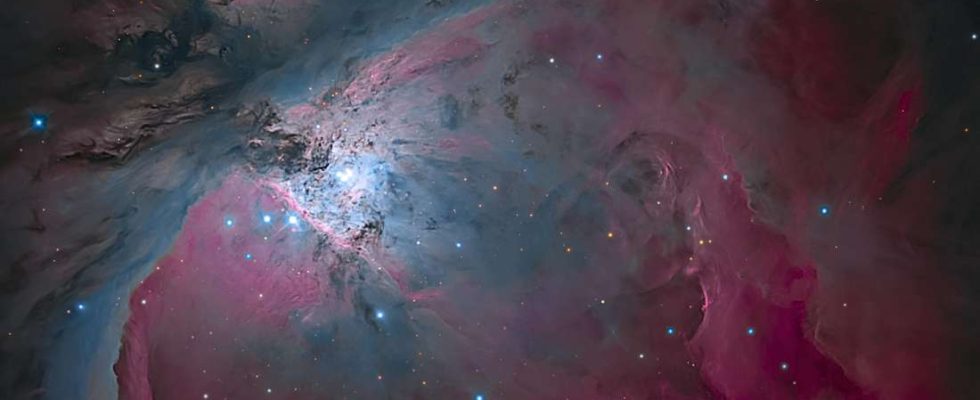Thanks to the sharp eye of the “James Webb” space telescope, two researchers discovered previously unknown celestial bodies, the “JuMBOs,” in the Orion Nebula.
Noordwijk – Anyone who looks up at the dark sky in autumn and winter can see it with the naked eye: the Orion Nebula. It is not only a popular observation object for telescope beginners, professional astronomers also like to take a closer look at the Orion Nebula and the Trapezium, an open star cluster in the center of the Orion Nebula. After all, it is the star formation region closest to Earth and is therefore also interesting for research.
Therefore, it was only a matter of time before the James Webb Space Telescope (JWST) of the space organizations Nasa, Esa and CSA was aimed at the Orion Nebula. A research duo from the European Space Agency Esa has now even made a surprising discovery in the JWST data. Samuel Pearson and Marc McCaughrean called the celestial bodies they newly discovered in the Orion Nebula “JuMBOs”. The abbreviation stands for “JupiterMass Binary Objects”, i.e. binary objects the size of the planet Jupiter.
“JuMBOs” appear to contradict basic astronomical theories
“The ‘JuMBOs’ are pairs of planet-like objects that float alone through space without being bound to any stars,” explains study author Pearson when asked by fr.de from IPPEN.MEDIA. Most of the objects would have a similar mass to Jupiter, and the pairs would orbit each other in very wide orbits.
“This was a truly unexpected discovery,” emphasizes Pearson, explaining why: “Scientists have been working on theories and models for the formation of stars and planets for decades, but none of them have ever predicted that we would have pairs of very low-mass objects “We would find people floating alone in space – and we see a lot of them.”
Space Newsletter
Subscribe to the free space newsletter and stay up to date.
The big question now is: How did the “JuMBOs” come about? Like stars, they could have formed from a collapsing gas cloud. But there’s a catch, says Pearson: “Physics suggests that it shouldn’t be possible to form such small individual objects directly from dust and gas clouds, let alone in pairs.” In addition, decades of observation have shown that smaller ones Objects rarely appear in pairs. The expert’s verdict: “It is very difficult to imagine a star-like formation of ‘JuMBOs’ unless something fundamental is missing in our understanding of physics.”
Scientists have been working on theories and models for the formation of stars and planets for decades, but none of them have ever predicted that we would find pairs of very low-mass objects floating alone in space – and we see a lot of them.
“JuMBOs” are neither stars nor planets – so how did they form?
The researchers also have a similar situation with planet-like formation: it is well known that planets can form in an orbit around their host star and then be thrown out of the orbit into space. “But how can you eject a pair of planets that still stay together?” asks Pearson. The researcher is surprised: “An interaction that is so violent that it tears a pair of planets away from its star, but somehow does not separate them – that is astonishing.”
The existence of “JuMBOs” obviously raises questions that research cannot currently answer. “The most important thing we learn from the existence of JuMBOs is that there is something fundamentally wrong with either our understanding of planet formation, star formation, or both,” says Pearson. The study by the two researchers was on the preprint server ArXiv published and submitted to a specialist magazine for publication.

New observation of the “JuMBOs” with JWST is already planned
At the beginning of 2024, the researchers want to use the “James Webb” telescope to target the Orion Nebula again and examine the newly discovered celestial bodies in more detail. “We will use the NIRSpec instrument to observe and record spectra of the JuMBOs and other objects with planetary mass,” says the ESA researcher. The plan is to take a much more detailed look at the objects and their atmospheric composition. “We hope this will provide the clues needed to solve the mystery of how they came to be,” emphasizes Pearson. (tab)

